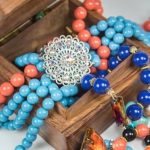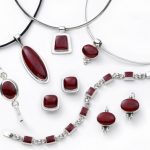Gold plated jewelry is a type of jewelry that features a thin layer of gold applied to another metal such as brass. This often can create beautiful pieces of jewelry at much lower costs than pure gold items which makes it attractive for many buyers. To repair these pieces, you have a few options depending on the nature and type of repair that needs to be done.
Potential Repairs
If the piece has undergone wear and tear such as scratches or chipping, it may just require polishing up a bit to give it the extra luster you are seeking. The good news is this type of repair can typically be done at home with a simple polishing cloth.
Simply use one side of the cloth to gently buff out any imperfections on the surface of the plating and then proceed to use the other side of the cloth in more circular motions afterwards. This should restore your piece back to its original form.
Sometimes, however, you may need more intensive repairs that span beyond general cleaning and polishing methods. If there is complete discoloration or large amounts of plating coming off from wear and tear, it may be time to take it in for professional help from an experienced jeweler or metalsmith who specializes in gold plating jewelry repairing.
These experts would be able to further assess your needs and provide their expertise on what could be done for your unique case. It is also recommended for those whose pieces contain intricate details as careful handling must be given when making repairs so as not to compromise any existing workmanship on your product such as stones settings or carvings.
Conclusion: Seeking Professional Help May Prove Beneficial
Ultimately, while some minor repairs involving gold plated jewelry can indeed be attempted at home, major cases should always seek help from an expert in order to preserve quality of the product in question. With proper care, you can certainly have stunning pieces that last indefinitely but do remember that an experienced eye is always needed during times where larger scale repairs are necessary so make sure you trust only trusted people when seeking assistance outside your own home.
How Gold Plating is Applied to Jewelry
Gold plated jewelry is a popular fashion choice thanks to its attractive design and low prices. It consists of a layer of gold electroplated onto another metal, and is often bought when designing intricate and elaborate pieces.
While the high shine provided by gold plating makes the items look great, this type of jewelry can be prone to wear and tear over time. Thankfully, there are many ways you can repair these items yourself and keep them looking their best for longer.
The first step to repairing gold-plated jewelry is understanding how it was applied. Gold plating involves bonding a thin layer of pure gold over a metal base such as stainless steel or brass using an advanced electrochemical process.
During this process, the gold attaches itself to the base material thanks to an electrical current passing through it. As the electronic current is adjusted, so too is the thickness of the resulting layer of gold plating – typically anywhere from 0.175 microns up to 2.5 microns thick depending on one’s preference.
Now that you know how your particular piece was plated it’s time to make repairs if needed. If you’ve noticed signs of corrosion or discoloration on your gold-plated jewelry, there are steps you can take before sending it out for professional repairs.
The most basic task would be simply cleaning it using mild soap and warm water with a soft cloth until all dirt has been removed from the area in need of work – this should restore some shine if not all of it. Additionally, if scratches are present then polishing or refinishing may do the trick; taking caution not to overwork any one area as this could damage your precious piece further.
If more intensive repairs are required then don’t be afraid to contact a local jeweler who will likely offer restoration services at reasonable prices since they specialize in tasks like this often. The process generally involves touching up areas with new layers of jewelry-quality gold plating material so as to replicate its original look & luster; much like repainting car parts would do for an aged automotive finish.
However, only certain metals are compatible with such repair techniques thus making sure you talk with experienced experts beforehand remains essential when dealing with these types of repairs.
Identifying Gold Plating Qualities and Their Issues
Gold plating is a great way to give jewelry a luxurious and beautiful look. Gold plating is slightly different than gold filled and solid gold items, as it usually has a thinner layer of gold covering an item made of a base metal like brass or copper.
Though the decent quality gold plated jewelry looks good at first, sometimes after prolonged use, the plating may start to wear off. In these cases, it’s worth considering whether you can repair gold plated jewelry rather than replacing the item completely.
In order to determine if repairing gold plated jewelry is possible you must assess the item’s quality first of all. The ideal type of gold plated jewelry has a thick layer of gold (up to 100 millionths of an inch thick) which usually lasts for years when cared for properly.
Thus, if your item has been stored away from direct heat, moisture and other corrosive elements, then chances are it still has enough depth in its plating for it to be repaired. Alternatively, many people choose to upgrade their items with heavier 14 carats or 18 carats for higher durability and beauty; this too means that there’s still hope for you.
Before attempting any repairs on your own you should stop back at the store where the piece was purchased. They may be able to re-plate the piece or if not they can advise you on where best to go – such as finding a reliable local jeweler who specializes in recovering old pieces back into existence.
Additionally, homeowners with access to materials (generally sold retail) may consider trying electrochemical restoration – here by connecting two rods made out of metal with electricity passing between them – more corrosion resistant properties can result without affecting the item aesthetically; although this process requires materials like Twag balm and specialized cleaning solutions so it could be best left up to professionals.
Is Repairing Gold Plated Jewelry Possible?
Yes, in most cases, it is possible to repair gold plated jewelry. Gold plating is not a permanent process and overtime the layer of gold may start to fade or wear off.
This will result in an uneven and patchy covering of gold on the piece of jewelry in question. One option for repair is to have the piece professionally re-plated which will cost more money but the result will be a restored look that could last longer than previous repairs.
The other option which can be considered when repairing gold plated jewelry is to do it at home. If you think the problem lies within contact surface then cleaning it may help restoring luster and color of the steel beneath.
You can also use a polish cloth specially made for polishing gold or soak your item in warm soapy water and then scrub with an old toothbrush to get rid of dust and dirt on the surfaces and any stubborn stains you might encounter.
Some people also recommend dipping your item into a bowl filled with white vinegar for about 10 minutes before scrubbing it with an old toothbrush after submerging. This will best restore the original sheen of the piece without having to re-plate it completely.
Assessing If a DIY Jewelry Repair is an Option
Gold plated jewelry is sometimes prone to wear and tear, much like any other piece of jewelry. It can be difficult to decide whether it should be repaired or replaced. Before making the decision, it’s first important to assess if a DIY jewelry repair is an option. The answer to this will depend on the condition of the jewelry and the extent of damage.
If only minor repairs need to completed, then carrying out these repairs yourself may be the best solution. However, if further investigation is required in order to evaluate the proper repair course of action, then seeking professional help would be more suitable for your needs. If DIY repairs are deemed possible however, there are various techniques and techniques available which may help you complete them.
For example, when fixing a broken chain link, it can often be done with metal cutters or wire-working tools such as round-nosed pliers and needle-nose pliers. When reattaching hanging pieces, usually jump rings and woven loops can be used as they respond quite well to jewelry glue.
Additionally, cleaning dirty gold plated pieces is also a simple process that doesn’t require any toolsc – simply mild soap and water will suffice when combined with a soft brush or cloth depending on surface details such as gemstones or intricate carving work.
It is important to remember however that gold plated items should never be exposed to abrasive cleansers or polishes since these tend to strip away each layer thus reducing the effectiveness of any attempted DIY repair in the future. Therefore if a piece of jewelry ever seems too delicate for self-repairing attempts it might be suggested one seeks professional advice prior so as not to worsen any damages done.
Investigating Resale Options with Jewelry Repair
The prospect of repairing gold plated jewelry can be compared to a sticky situation. Depending on the quality and craftsmanship of the item, it may be best to part ways with your gold plated jewelry and find something new, rather than attempting repairs. One option is to look into selling or swapping your old item for a new piece.
You can often find shops or programs that specialize in buying used jewelry and then reselling it at a price substantially lower than retail rate. This approach gives you an opportunity to repurpose your gold plated jewelry, while also pocketing some extra money.
Another option is taking your gold plated jewelry to a trained professional such as an appraiser or repair service provider. An appraiser is someone who specializes in assessing the monetary value of certain items, including pieces of jewelry. This route would answer any burning questions you may have about whether repair solutions would pay off, if the cost of said solutions wouldn’t outshine the potential gain from having the item repaired, and ultimately about its overall resale worth.
On top of these options, there are a few additional repair-based options too. You may choose to tackle the repairs yourself; however we do advise against this since inappropriate repairs may damage jewelry beyond recognition. As mentioned prior, some gold plated jewelry comes with extensive craftsmanship work which makes it hard to fix missing details even when done by professionals.
Understanding the Process of Gold Plating in Jewelry Repair
Sometimes jewelry needs repairing, especially gold plated items. The process of servicing or repairing jewelry is unique and different from other repairs because it requires specific techniques and skills to ensure that the repair does not damage the existing plating. Gold plating can add value and aesthetic appeal to jewelry.
For example, a gold overlay is applied over a metal base to give a piece an elegant, beautiful appearance. It’s more affordable than solid gold too. But precisely because it’s more affordable, it also means these pieces wear faster compared to other metals like silver.
So if you need to repair your gold plated necklace, bracelet or earring – whether it’s due to broken chains or clasps, worn down refinished surfaces or any other problems – knowing how exactly the process works is important and quite helpful in deciding how best to address the issue at hand.
The first step when it comes to gold plating or any kind of metal repairs is re-plating, which involves the use of an electrolytic solution (where electricity passes through liquid molecules) for applying thin layers of fresh plate onto a surface in order to restore its original look.
This solution can be applied only by a professional who uses special techniques for ensuring better adherence and stronger protection of the metal surface including using certain chemicals that work against oxidation.
Additionally, there could be some polishing required for enhancing its visual beauty and restoring its brightness as desired.
Lastly re-finishing often involves adding gems like diamonds or emeralds back into the piece so as to make sure they stay secure, while maintaining their brilliance across time. Moreover this step may also include replacing stones due to aging, structural damage etc., all while preserving the original design of the item being serviced/repaired.
Exploring Professional Jewelry Repairer Options
If you have gold plated jewelry that needs repair, the best option may be to take it to a professional jeweler. Professional jewelers have the tools and expertise to make repairs that may require special skills and techniques. Because gold plating is a delicate process and can easily be damaged, a jewelry repair specialist can ensure quality workmanship. Even tiny repairs may require costly polishing and replating if done incorrectly.
It’s important to note that gold plated jewelry is often not as strong as solid gold because the base metal used for the plating provides an intrinsic weakness. For example, if a piece of plated jewelry becomes bent or twisted while worn on the body, it’s likely that it will remain misshapen even after being professionally repaired. Therefore, artisanal work may be needed to restore its shape completely.
If your gold plated jewelry simply needs polishing or cleaning with a damp cloth or soft brush use only mild detergents specifically designed for cleaning gold-plated pieces. Specific advice should be obtained from your jeweler depending on the type of metal used for the underlying layer of your particular piece of jewelry, as some cleaning methods are suitable only for certain types of metals.
Be sure to caution your jeweler if they suggest using buffing wheels when cleaning any non-plated surfaces which could scratch or damage them due to their weaker structures or possible undertones underneath them.
Going Through Common Gold Plated Jewelry Repair FAQs
In general, repairing gold-plated jewelry is no more difficult than working with sterling silver or any other metal alloy. The two biggest differences when it comes to repair on a gold-plated piece are first, the complexity of the design; and second, how care needs to be taken with the item as it can wear away easily.
Knowing what type of repair is possible and what tools may be needed for the job is key in helping to determine if you should try this yourself at home or if it’s best left to a professional.
Questions often arise when needing to repair a gold-plated item about how specifically that process should take place. Is more gold plating needed? What type of maintenance is needed? Fortunately, there are some general questions and common answers that can provide insight into this area:
One common FAQ concerning gold plated jewelry repair is “What types of repairs can I handle myself at home?” If dealing with small scratches or corrosion around the edges of a piece, these generally can be handled DIY by someone familiar with polishing or cleaning techniques. Light tarnish may also cause discoloration along with deep etchings being common areas where cleaning agents are used to create deep shine.
If you have simple broken jump rings or missing stones/clasps, lubricants help prevent further damage caused over time from everyday wear and tear meanwhile strengthening the jewelry against breakage if its continuously worn in a particular spot. Professional jewelers mostly use soldering techniques along with clamps and dedicated tools for delicate pieces in order to minimize any lateral forces on the precious metals used during welding operations.
For serious repairs like replacing beads or cutting off excess ends face metal reworking calls for deeper knowledge due to certain intricacies as various colored metal alloys require specialized treatments before replating. A properly trained jeweler will know how to work around such problems and deliver satisfactory results over time restoring quality pieces of beautiful jewelry back into their original condition.

Welcome to my jewelry blog! My name is Sarah and I am the owner of this blog.
I love making jewelry and sharing my creations with others.
So whether you’re someone who loves wearing jewelry yourself or simply enjoys learning about it, be sure to check out my blog for insightful posts on everything related to this exciting topic!





